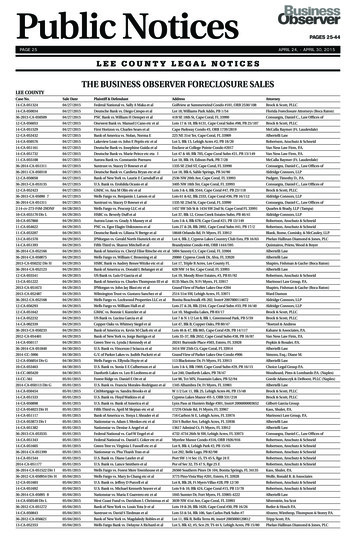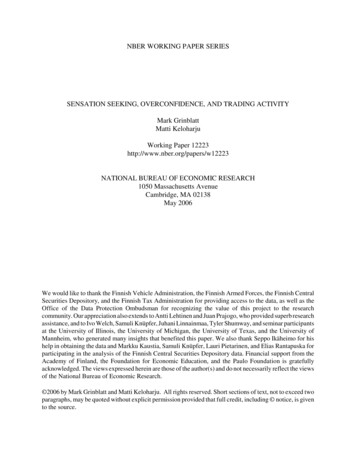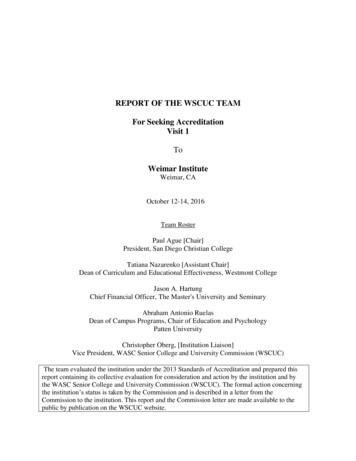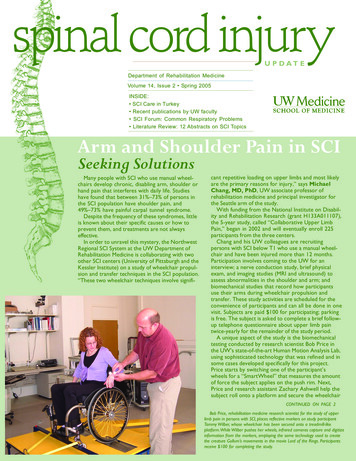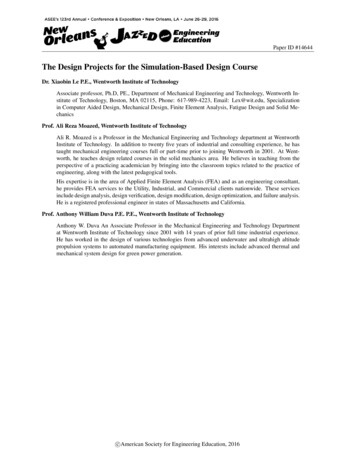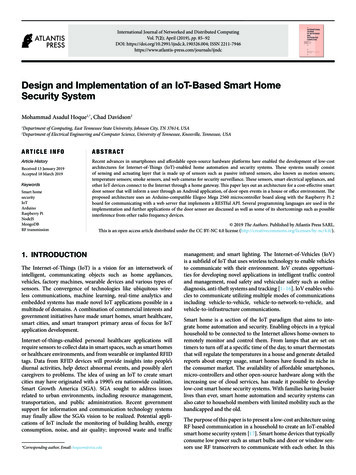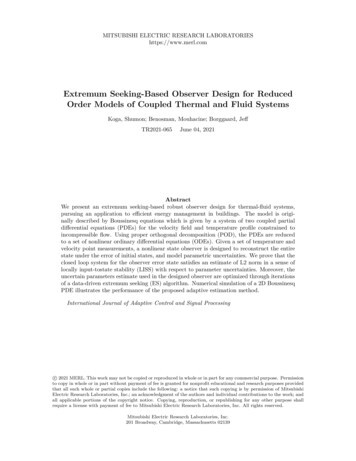
Transcription
MITSUBISHI ELECTRIC RESEARCH LABORATORIEShttps://www.merl.comExtremum Seeking-Based Observer Design for ReducedOrder Models of Coupled Thermal and Fluid SystemsKoga, Shumon; Benosman, Mouhacine; Borggaard, JeffTR2021-065June 04, 2021AbstractWe present an extremum seeking-based robust observer design for thermal-fluid systems,pursuing an application to efficient energy management in buildings. The model is originally described by Boussinesq equations which is given by a system of two coupled partialdifferential equations (PDEs) for the velocity field and temperature profile constrained toincompressible flow. Using proper orthogonal decomposition (POD), the PDEs are reducedto a set of nonlinear ordinary differential equations (ODEs). Given a set of temperature andvelocity point measurements, a nonlinear state observer is designed to reconstruct the entirestate under the error of initial states, and model parametric uncertainties. We prove that theclosed loop system for the observer error state satisfies an estimate of L2 norm in a sense oflocally input-tostate stability (LISS) with respect to parameter uncertainties. Moreover, theuncertain parameters estimate used in the designed observer are optimized through iterationsof a data-driven extremum seeking (ES) algorithm. Numerical simulation of a 2D BoussinesqPDE illustrates the performance of the proposed adaptive estimation method.International Journal of Adaptive Control and Signal Processingc 2021 MERL. This work may not be copied or reproduced in whole or in part for any commercial purpose. Permissionto copy in whole or in part without payment of fee is granted for nonprofit educational and research purposes providedthat all such whole or partial copies include the following: a notice that such copying is by permission of MitsubishiElectric Research Laboratories, Inc.; an acknowledgment of the authors and individual contributions to the work; andall applicable portions of the copyright notice. Copying, reproduction, or republishing for any other purpose shallrequire a license with payment of fee to Mitsubishi Electric Research Laboratories, Inc. All rights reserved.Mitsubishi Electric Research Laboratories, Inc.201 Broadway, Cambridge, Massachusetts 02139
INTERNATIONAL JOURNAL OF ADAPTIVE CONTROL AND SIGNAL PROCESSINGInt. J. Adapt. Control Signal Process. 2019; 00:1–26Published online in Wiley InterScience (www.interscience.wiley.com). DOI: 10.1002/acsExtremum Seeking-Based Observer Design for Reduced OrderModels of Coupled Thermal and Fluid SystemsShumon Koga, Mouhacine Benosman , Jeff BorggaardS. Koga, intern at MERL, is with the Department of Mechanical and Aerospace Engineering, U.C. San Diego, 9500Gilman Drive, La Jolla, CA, 92093-0411. M. Benosman is with Mitsubishi Electric Research Laboratories (MERL),Cambridge, MA, 02139. J. Borggaard is with the Interdisciplinary Center for Applied Mathematics, Virginia Tech,Blacksburg, VA, 24061SUMMARYWe present an extremum seeking-based robust observer design for thermal-fluid systems, pursuing anapplication to efficient energy management in buildings. The model is originally described by Boussinesqequations which is given by a system of two coupled partial differential equations (PDEs) for the velocityfield and temperature profile constrained to incompressible flow. Using proper orthogonal decomposition(POD), the PDEs are reduced to a set of nonlinear ordinary differential equations (ODEs). Given a setof temperature and velocity point measurements, a nonlinear state observer is designed to reconstruct theentire state under the error of initial states, and model parametric uncertainties. We prove that the closedloop system for the observer error state satisfies an estimate of L2 norm in a sense of locally input-tostate stability (LISS) with respect to parameter uncertainties. Moreover, the uncertain parameters estimateused in the designed observer are optimized through iterations of a data-driven extremum seeking (ES)algorithm. Numerical simulation of a 2D Boussinesq PDE illustrates the performance of the proposedadaptive estimation method. Copyright c 2019 John Wiley & Sons, Ltd.Received . . .KEY WORDS: Extremum seeking, iterative feedback tuning, thermo-fluid models, observer design,input-state stability, Boussinesq equation.1. INTRODUCTIONThermal and fluid systems have been intensively studied for numerous applications in science andengineering processes. For instance, an efficient energy management for heating, ventilation, and Correspondingauthor:m benosman@ieee.orgCopyright c 2019 John Wiley & Sons, Ltd.Prepared using acsauth.cls [Version: 2010/03/27 v2.00]
2S. KOGA ET AL.air conditioning (HVAC) systems has been a priority research topic for many countries due to itshuge energy consumption impact [6].One of the important problems in HVAC management is to estimate the entire spatial profileof the airflow and temperature under a limited number of sensors placed at some locations inbuildings. Such a state estimation for Navier Stokes (NS) equations has been investigated in anumber of literatures in the recent decade. In [8], an infinite dimensional Kalman filter is designedfor a linearized NS equation around the velocity field of interest. Their approach showed goodperformance as a first contribution to fluid estimation, however, there are two issues from theperspective of real implementation. One is the linearization assumption of NS equations, canproduce a low fidelity fluid model. A second drawback is the high computational cost for thediscretization of the infinite dimensional filter. To improve these issues, in [11], the authorsdeveloped a POD-based model reduction for NS equations, and designed extended Kalman filterfor the state estimation, which illustrated the effective results on estimated velocity profile. Thelater work on state estimation for POD-ROM of NS equations can be found in [12, 15].For higher fidelity models of the NS equation which include the effect of buoyancy forces drivenby the density change via temperature dependence. The dynamics of the temperature profile is alsodescribed from the conservation of energy, which formulates the Boussinesq equations as a coupledthermal and fluid systems. Due to the coupled nonlinearity of two PDEs, the design and analysis ofBoussinesq equations is highly challenging problem especially for 2D and 3D domains. Moreover,as presented in [13], POD-based model reduction might lose the stability property of the statevariables, which is caused by the truncation of higher order modes serving as a stabilizing factor.While there are several methods for model reduction, the modal analysis has been successfullyemployed for PDEs with state constraints in [10, 23].The stable model reduction for Boussinesq equations is developed in [4] by introducing a newclosure model, which robustly stabilizes the reduced order model. The authors prove the robuststability of the closure model with respect to the parameters uncertainty using Lyapunov analysis.Furthermore, the gains in the closure terms are auto-tuned by learning-based extremum seeking(ES) algorithm to minimize the errors between the true model solution and the ROM solution. Theconvergence analysis of ES is established in [14] by means of singular perturbation and averagingtheorem, and an approach to apply ES for parameter auto-tuning in POD-ROM is originated in[5]. The results in [4] illustrate a good performance in improving solution prediction for laminarflows, however, the method relies on the accurate knowledge of the initial velocity and temperatureprofiles, which can be relaxed by state estimation technique utilizing sparse measurements obtainedthrough a few sensors.There are two contributions in this paper. First, we have investigated the robustness of thedesigned observer for POD-ROM of Boussinesq equation with respect to the uncertainty of viscosityCopyright c 2019 John Wiley & Sons, Ltd.Prepared using acsauth.clsInt. J. Adapt. Control Signal Process. (2019)DOI: 10.1002/acs
EXTREMUM SEEKING-BASED OBSERVER DESIGN FOR REDUCED ORDER MODELS OF COUPLED THERMAL AND FLUID SYSTEMby proving input-to-state stability (ISS) in a local sense using Lyapunov method. The observergain is designed via LMI approach to satisfy a condition for ISS proof. Second, as in [4], theonline estimation of the uncertain viscosity parameter is implemented using a data-driven extremumseeking.This paper is structured as follows. In Section 3, the physical model of thermal and fluid systemsis introduced by means of Boussinesq equations, and its POD-ROM is derived. Section 4 is devotedto the observer design for POD-ROM, where we provide the robustness analysis with respect toparameter uncertainty. In Section 5, the online estimation of the uncertain parameter in the designedobserver is performed by ES as an iterative learning estimation, and Section 6 presents the numericalverification of the proposed method for 2-D Boussinesq equations. The paper ends with a conclusionand future works, as stated in Section 7.2. PRELIMINARY DEFINITIONSThroughout the paper, we use k · k to denote the Euclidean norm; i.e., for a vector x Rn , we have kxk , kxk2 xT x, where xT denotes the transpose of the vector x. The Frobenius norm of aqP Pnnm2matrix A Rm n , with elements aij , is defined as kAkF ,i 1j 1 aij . Given x R .We use f to denote the time derivative of f and f (r) (t) for the r-th derivative of f (t), i.e.,f (r) ,dr fdtr .We denote by Ck , functions that are k times differentiable and by C , a smoothfunction. A continuous function α : [0, a) [0, ) is said to belong to class K if it is strictlyincreasing and α(0) 0. It is said to belong to class K if a and α(r) as r [1].A continuous function β : [0, a) [0, ) [0, ) is said to belong to class KL if, for a fixed s,the mapping β(r, s) belongs to class K with respect to r and, for each fixed r, the mapping β(r, s)is decreasing with respect to s and β(r, s) 0 as s [1]. Finally, for a Hilbert space H, weRdefine the inner product h·, ·iH and the associated norm k · kH on H as hf, giH Ω f (x)g(x)dx,Rfor f, g H, and kf k2H Ω f (x) 2 dxNext, we introduce some definitions that will be used in the sequel, e.g. [1]: consider the system(1)ẋ f (t, x, u),where f : [0, ) Rn Rm Rn is piecewise continuous in t and locally Lipschitz in x and u,uniformly in t. The input u(t) is piecewise continuous, bounded function of t for all t 0.Definition 1 ([1, 2])The system (1) is said to be input-to-sate stable (ISS) if there exist a class KL function β and a classK function γ such that for any initial state x(t0 ) and any bounded input u(t), the solution x(t) existsCopyright c 2019 John Wiley & Sons, Ltd.Prepared using acsauth.clsInt. J. Adapt. Control Signal Process. (2019)DOI: 10.1002/acs
4S. KOGA ET AL.for all t t0 and satisfieskx(t)k β(kx(t0 )k, t t0 ) γ( sup ku(τ )k).t0 τ tTheorem 1 ([1, 2])Let V : [0, ) Rn R be a continuously differentiable function such thatα1 (kxk) V (t, x) α2 (kxk), V V f (t, x, u) W (x), t x kxk ρ(kuk) 0,(2)for all (t, x, u) [0, ) Rn Rm , where α1 , α2 are class K functions, ρ is a class K function,and W (x) is a continuous positive definite function on Rn . Then, the system (1) is input-to-statestable (ISS).3. MODELLING OF THERMAL AND FLUID SYSTEMS3.1. Boussinesq equations and normalizationWe focus on the dynamics of the velocity field v(x, t) : Ω R R3 and the temperature profileT (x, t) : Ω R R, where x denotes the spatial coordinate x Ω, and t 0 denotes the time.The spatial domain Ω can be two or three dimensional space. The governing equations are describedby Navier-Stokes equation with the condition of incompressible flow and the conservation of theenergy through the heat transfer, which leads to the following coupled system ρ ρcp v v · v t p · τ (v) ρg, · v 0, T v · T (κ T ) , t(3)(4)(5)where ρ [kg/m3 ] is the density profile, p [kg/(ms2 )] is the pressure field, τ (v) is the viscous stress,cp [J/kg K] is the constant heat capacity, κ [W/m K] is the constant thermal conductivity, and g ge3 [m/s2 ] is the gravitational force. In Boussinesq approximation, the buoyancy force is drivenby changes in density ρ ρ0 ρ from the nominal density ρ0 , and the density change is modeledas perturbations from the nominal temperature T0 using the perfect gas law ρg ρ0 β(T T0 )g ,β 1/T0 , and the constant term ρ0 g is absorbed into the pressure. The viscous stress is governedby τ (v) ρν( v v T ) with kinematic viscosity ν [m2 /s], whereas the velocity v is in [m/s],and the temperature T is in [K].Copyright c 2019 John Wiley & Sons, Ltd.Prepared using acsauth.clsInt. J. Adapt. Control Signal Process. (2019)DOI: 10.1002/acs
EXTREMUM SEEKING-BASED OBSERVER DESIGN FOR REDUCED ORDER MODELS OF COUPLED THERMAL AND FLUID SYSTEMBy introducing a characteristic length L, characteristic velocity v0 , wall temperature Tw , wedefine the following normalized statesx̃ x,Lp̃ t̃ p,ρv02tv0,Lv,v0T T0T̃ .Tw T0(6)ṽ (7)Using these variables, PDEs (3)–(5) can be reduced to the following (we dropped the tilde notation)Gr vT e3 , v · v p · τ (v) tRe2(8) · v 0, T v · T twhere we defined Reynolds number Re number Pr (9) 1 TRePrv0 Lν , (10),Grashof number Gr gβ(Tw T0 )L3,ν2and Prandtlnuk/ρ0 cp .3.2. POD Model ReductionFollowing Galerkin projection onto the subspace spanned by the POD basis functions, we havev pod (x, t) v0 (x) T pod (x, t) T0 (x) rvXqi (t)φvi (x),i 1rvX rT(11)qi (t)φTi (x),(12)i rv 1where v0 (x) and T0 (x) are the steady-state solution to (3)–(5), φvi (x) and φTi (x) are POD basisfunctions given byφvi (x) tf1tfZ1tfZ(vsim (x, t) v0 (x))wi (t)dt,(13)(Tsim (x, t) T0 (x))wi (t)dt,(14)0for i 1, · · · , rv , andφTi (x) forR tf0i rv 1, · · · , rv rT ,withtf0theorthogonalwightfunctionswi (t)satisfyingwi (t)wj (t)dt 0 if i 6 j . The coefficients qi (t) in (11) and (12) are the dynamical statesrepresenting the POD-ROM of the Boussinesq equations.Remark 1POD-projection error, e.g., [24]: Let T : H Ĥ be the orthogonal projector from H (infinitedimension Hilbert space) to the finite dimension space Ĥ (hence, kT kH 1 and T † be the injectionfrom Ĥ into H: T † ẑ z for all ẑ Ĥ H. Then we define the reduced estimation error ase(t) ẑ(t) T z(t) Ĥ.Copyright c 2019 John Wiley & Sons, Ltd.Prepared using acsauth.cls(15)Int. J. Adapt. Control Signal Process. (2019)DOI: 10.1002/acs
6S. KOGA ET AL.This can be used as a proxy for the state estimation errorese T † ẑ z H,(16)when T produces a small projection error (z T † T z ), since ese (t) T † e(t) z(t) T † T z(t) .(17)When Ĥ is the span of r dominant POD basis functions and TPOD is the corresponding projectionfor a specific trajectory z , i.e., T TPOD : H Ĥr as follows[TPOD z] (·) rX(18)φi (·)hφi , ziH .i 1then TPOD minimizes the projection error Z tf 1/2†2kz(t) T T z(t)kH dtP(T , z) ,(19)0over all projections T into subspaces of H with dimension r, and where tf denotes the finite timesupport over which the projection error is evaluated, cf. [25].By defining the state vector q(t) [q1 (t), q2 (t), · · · , qrv rT (t)]T , we obtain the following ODE(see [4] for the detailed derivation)(20)q̇(t) µDq(t) [Cq(t)]q(t) b,where µ 0 is the viscosity µ 1Re ,D is a negative definite diffusion matrix with diagonal blockscorresponding to the viscous stress and thermal diffusion, and C is a three-dimensional tensorcorresponding the convection terms in (8) and (10). In the remaining of this paper, we shall callthe model (20) as ROM-G (G for Galerkin).Remark 2While the original PDEs (3)–(5) is a system that has bounded solutions from our knowledgeon thermal and fluid dynamics, the obtained POD-ROM (20) might exhibits radially unboundedsolutions depending on the strength of the quadratic nonlinearity [Cq(t)]q(t) and the constant termb relative to the damping effect µDq(t). We study the effect of µ on the boundedness of the solutionto (20) in the next lemma.Lemma 1For a viscosity coefficient satisfyingµ npo2maxcmax bmax , cmax q0 ,d(21)where d : λmin ( D) 0, cmax C F , bmax b , the following explicit bound holdsb̄ q Y cmax Copyright c 2019 John Wiley & Sons, Ltd.Prepared using acsauth.cls b̄ q0 Y , cmax eb̄t(22)Int. J. Adapt. Control Signal Process. (2019)DOI: 10.1002/acs
EXTREMUM SEEKING-BASED OBSERVER DESIGN FOR REDUCED ORDER MODELS OF COUPLED THERMAL AND FLUID SYSTEMwhere b̄ pµd b̄2cmax .µ2 d2 4bmax cmax , and Y a positive constant M µd2cmax ,Moreover, the solution is uniformly bounded byi.e., q M .ProofConsider the following Lyapunov functionV q T q q 2 .(23)Taking the time derivative of (23) and using (20) yieldsV̇ µq T (D DT )q 2[Cq]q T q 2bT q.(24)Due to the negative definiteness of D DT 0, we haveq T (D DT )q 2d q 2 .(25)By the Cauchy Schwarz inequality, it holds that[Cq]q T q cmax q 3 ,bT q bmax q .(26)Applying (25) and (26) to (24), one can derive the following differential inequalityV̇ 2µd q 2 2cmax q 3 2bmax q .(27)Next, we consider Y V q .(28)Then, the time derivative of (28) isẎ V̇2Y µdY cmax Y 2 bmax(29)Applying comparison principle to (29), Y is bounded by the solution to the Riccati differentialequation ẏ µdy cmax y 2 bmax with initial condition y(0) Y (0). If the viscosity issufficiently large to satisfy (21), the solution of y(t) is given by the right hand side of (22). Hence,Y satisfies the inequality (22). Moreover, by condition (21), we have q0 µd2cmax .to (22), the bound q Y b̄the uniform bound q µd2cmaxb̄cmax (1 eb̄t )is obtained. Sinceb̄cmax (1 eb̄t ) 2cmaxApplying thisand Y µd b̄2cmax ,is deduced.3.3. Closure model for ROM stabilizationThe main idea behind the closure modeling is to replace the viscosity coefficient µ in (20) by avirtual viscosity coefficient µcl , which is chosen to stabilize the POD-ROM. Furthermore, a penaltyCopyright c 2019 John Wiley & Sons, Ltd.Prepared using acsauth.clsInt. J. Adapt. Control Signal Process. (2019)DOI: 10.1002/acs
8S. KOGA ET AL.term H(q(t)) is added to the POD-ROM as followsq̇(t) µcl Dq(t) F̃ (q) H(q(t)),(30)F̃ (q) [Cq(t)]q(t) b.(31)where F̃ (q) is defined asA well known choice of the virtual viscosity is the Heisenberg ROM (ROM-H) which is simplygiven by(32)µcl µ0 µe ,where µ0 is the nominal value of the viscosity coefficient, and µe is the additional constant addedto compensate for the loss of the damping effect of the truncated modes. The choice of H(q) ispresented in [4] based on the function of F̃ (q), by imposing the following assumption.Assumption 1There exists a C1 function f (q) : Rn R such that the norm of vector field F̃ (q) : Rn Rn isbounded, i.e., F̃ (q) f (q).(33)Using the vector field function (31), the bounded function f is given byf (q) cmax q 2 bmax ,(34)where cmax C F , and bmax b L . In [4], the authors proved the following lemma.Lemma 2Let Assumption 1 holds. Then, the reduced order model (30) withH(q) µnl f (q)D q,(35)µnl 0where D diag(d11 , d22 , · · · , drr ), stabilizes the solution of the ROM to the invariant set λmax (D) q nS q Rs.t. µcl µnl q max{d11 , · · · , drr } 1 0 .f (q)(36)Thus, the nonlinear reduced order model with closure model H is given byq̇(t) µcl Dq(t) [Cq(t)]q(t) b µnl (cmax q 2 bmax )D q.(37)In the remaining of this paper, we shall call the model (37) as ROM-CL (CL stands for closure).Copyright c 2019 John Wiley & Sons, Ltd.Prepared using acsauth.clsInt. J. Adapt. Control Signal Process. (2019)DOI: 10.1002/acs
EXTREMUM SEEKING-BASED OBSERVER DESIGN FOR REDUCED ORDER MODELS OF COUPLED THERMAL AND FLUID SYSTEM4. ROBUSTNESS OF NONLINEAR OBSERVER IN LOCAL ISS SENSE4.1. Observer based on the ROM
Extremum Seeking-Based Observer Design for Reduced Order Models of Coupled Thermal and Fluid Systems Shumon Koga, Mouhacine Benosman , Jeff Borggaard S. Koga, intern at MERL, is with the Department of Mechanical and Aerospace Engineering, U.C. S

